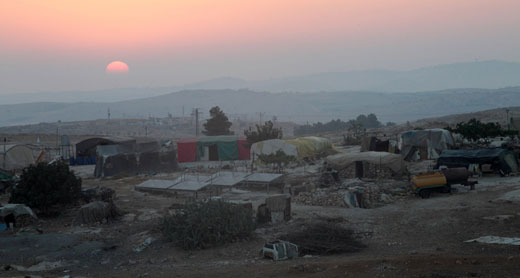Planning and construction policy for Palestinians in Area C
Published:
1 Jan 2011
Updated:
10 Nov 2013
Khirbet Susiya, South Hebron Hills: A village threated with demolition. Photo: Anne Paq
Even after the Oslo Accords, Israel retained full building and planning authority in Area C, which encompasses some 60% of the West Bank. Israel strictly limits Palestinian settlement, construction and development in this area, while ignoring the needs of the Palestinian population. This policy means Palestinian residents must subsist in very rudimentary living conditions. They are denied any legal avenue to build homes or develop their communities, so they face the constant fear that their homes might be demolished, and that they be expelled and lose their livelihood. The Civil Administration prohibits Palestinian construction in vast areas of Area C, citing various rationales, such as defining these areas as state land, survey land, firing zones, nature reserves and natural parks, or by incorporating lands into the jurisdiction of settlements and regional councils. In addition, the authorities prevent Palestinians from building even on lands that are enclosed between the Green Line and the Separation Barrier. After deducting for overlap among the various areas described above, Palestinians are prohibited from building on some 70% of Area C.
In the remaining 30% of Area C land on which constructions is not a priori prohibited, any construction must be pre-approved by the Civil Administration, be it for private homes, agricultural structures or infrastructure facilities. The Civil Administration, however, imposes severe restrictions on such building. To date, the Civil Administration has avoided approving any master plan at all for over 90% of the villages located entirely within Area C, and has approved master plans for only 16 villages. These plans, prepared without participation by local residents, fail to meet their needs. The boundaries set forth in these plans were determined according to the built-up areas of each village at the time of planning, thereby preventing expansion to meet population growth. The limited building area these master plans designated excluded land around the villages available for development, and sometimes, even excluded existing structures on the villages' outskirts. The plans do not designate areas for public purposes such as schools or medical clinics and impose a high population density. The total area covered by these plans is currently only about one half of one percent of Area C.
Given the Civil Administration's policy, the prospects for receiving a building permit outside the scope of the master plans are very slim. Therefore, most Palestinians feel it is futile to apply and do not even submit an application. The Civil Administration refuses to grant building permits even for public buildings, such as schools and medical clinics and to infrastructure such as roads. According to Civil Administration figures, between 2000 and 2012, the Civil Administration issued 9,682 demolition orders for Palestinian structures built without a permit and has demolished 2,829 of them. According toB'Tselem figures, from 2006 through September 2013, the Civil Administration demolished at least 624 Palestinian residential units in the West Bank (not including East Jerusalem), causing 3,075 people – including at least 1,457 minors – to lose their homes.
The Civil Administration rarely introduces initiatives for further development of Palestinian villages nor does it invests its own resources in such development, despite being the responsible agency. International organizations and the Palestinian Authority must undergo prolonged and tedious bureaucratic procedures in order to expedite projects they initiate in Area C, such as drilling wells, building sewage treatment facilities or paving roads. Israel’s policy in Area C is anchored in a perception of the area as meant above all to serve Israeli needs. Consequently, Israel consistently takes actions that strengthen its hold on Area C, exploit the area's resources for the benefit of its own population and bring about a permanent situation in which Israeli settlements thrive and Palestinian presence is negligible. Israel’s actions have brought about a de facto annexation of Area C and have created circumstances that will more easily enable it to influence the final status of the area.
With its policy in Area C, Israel abuses its basic obligations under international humanitarian law. Israel must allocate lands to Palestinians for housing, infrastructure and industrial zones. It must also pursue an expert planning process, with participation by the local Palestinian population, whose top priority will be the needs of this population. Until such a process is implemented, and so long as Israel retains planning authority in Area C and does not allow Palestinians to build legally, it must desist from demolition – including demolition of homes, business-related structures (e.g., buildings used for agriculture or trade) and rainwater-collection cisterns – and it must revoke all pending demolition orders against existing structures.

هیچ نظری موجود نیست:
ارسال یک نظر